Architizer is thrilled to announce that the 2026 A+Product Awards is officially open for submissions! Get your products in front of the AEC industry’s most renowned designers by submitting today.
How do you feel about kitchen cabinetry? Do you feel anything about kitchen cabinetry? It’s not the sort of building component that’s easy to feel a natural connection to. It’s not hardwood flooring, redolent of old Vermont barns; it’s not door handles, “the handshake of a building”; it’s not metal siding, shiny and euphoric in the sails of the future.
But cabinetry is what gives character to the kitchen, maybe the most emotionally connected room in a house. It’s important what kitchen cabinetry looks like, how it feels. Whatever hardware you put on those doors will forever be connected to the smell of someone’s grandparents’ cookies or mother’s chicken soup.

© Standard Studio - Interior Architecture
Ons Dorp Old School Conversion by Standard Studio – Amsterdam
We sat down with Hany Gerges, Senior Designer at Manhattan Center for Kitchen and Bath (MCK+B) to talk us through how to specify kitchen cabinetry. As Gerges said, “The kitchen is the most expensive room in a house,” and there’s a lot riding on getting it right.
The first thing we talked about is that architects often don’t specify kitchen cabinetry in the same way that you specify faucets or flooring. High-end premade kitchen cabinetry is still a growing industry. Much off-the-shelf cabinetry, like the kind available from IKEA, is typically used in home renovation projects and not in the higher-end or multiunit projects that architects typically work on. Premade cabinets have the big drawback that they come in a limited range of sizes, and kitchens have to be designed around them, as opposed to vice versa.
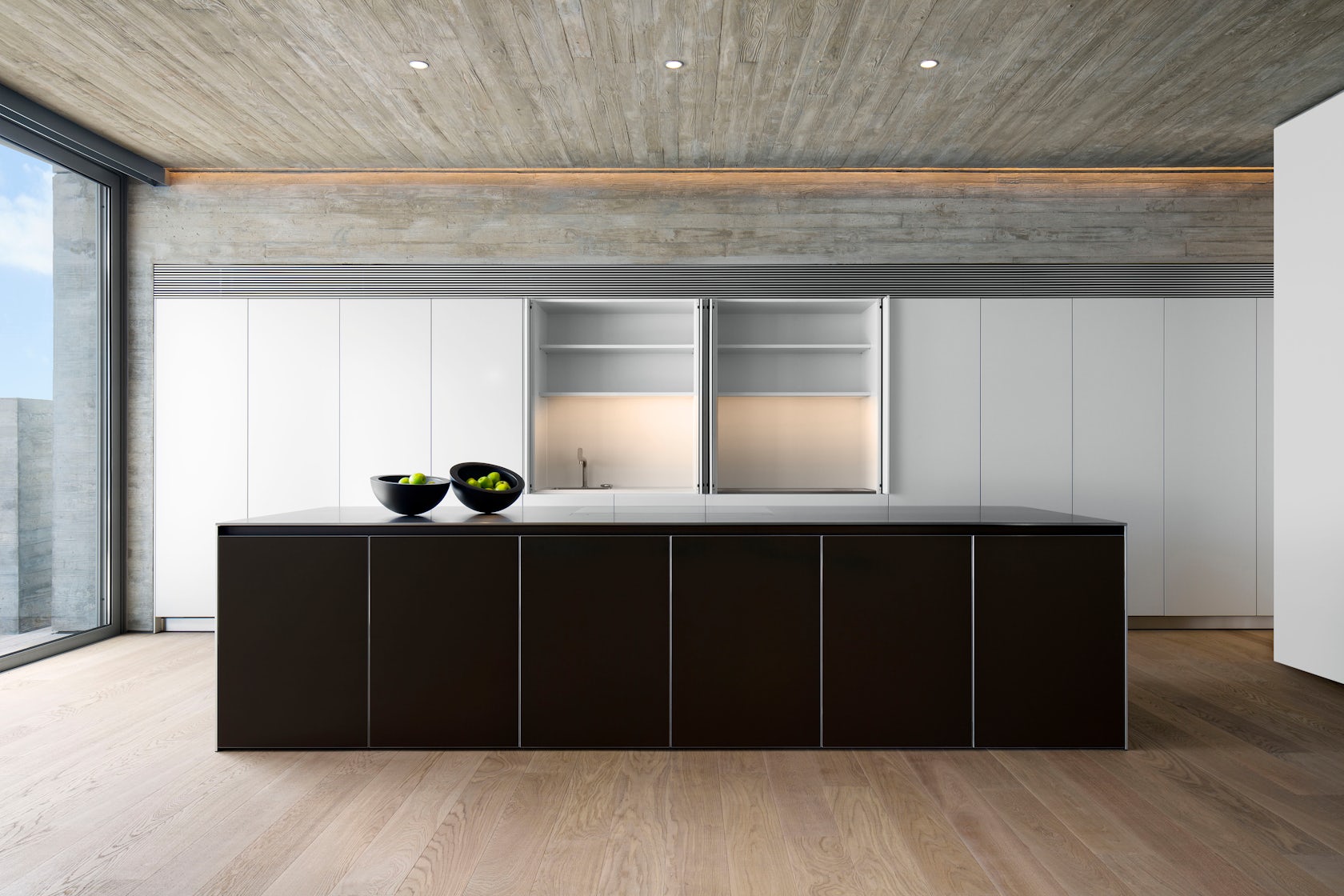
© Three14 Architects
Most kitchen cabinetry is specifically built and designed for each project. Usually that means that all finishes are completed in the factory and assembly and hardware installation is all that happens on-site. There are fabricators that specialize in kitchen cabinetry, and these companies, according to Gerges, are more sensitive to the needs of kitchen cabinetry than general mill workers.
If you’re not going with a predesigned system from a manufacturer, specifying kitchen cabinetry typically means picking door material and style and hardware. The style and material of cabinet doors, combined with the visible hardware, determines the aesthetic. You can specify doors or hardware as a set from some manufacturers or separately specify them. You can also design custom doors and specify off-the-shelf hardware. Dedicated kitchen designers, like those at Manhattan Center for Kitchen and Bath (MCK+B), can work with inexperienced designers to lay out plans and elevations and select materials and styles.

© YAEL PERRY | INTERIOR DESIGNER
S|H Apartment by YAEL PERRY | INTERIOR DESIGNER
Door Faces
Style: While any designer or architect can design and detail their own cabinet doors, most dedicated kitchen designers will have ready-made options to pick from or modify as needed.
- Traditional: Traditional designs typically are the most ornate and can involve complicated trim.
- Transitional: Transitional designs are less faithful to vernacular styles than traditional designs but still use stripped-down borders and inlays.
- Contemporary: Sleek, stripped-down cabinet doors are the new classic.
Material: Cabinet doors usually are either solid wood or particleboard and melamine, and the boxes of the cabinets usually are plywood.
- Solid wood: As with any other wood building component, a variety of species are available depending on your budget and desired aesthetic.
- Species: Wood greatly varies in aesthetic depending on the species of tree from which it is derived. The most common variants include oak, maple, hickory, birch and cherry, while more exotic woods include teak, acacia and tigerwood. Each has different colors, grain patterns, textures and even aromas. For a complete list, you can visit the Wood Database.
- Particleboard and melamine: The particleboard used in custom cabinetry typically is of a higher grade than the kind found in off-the-shelf products, so it will be stronger and more resistant to water damage.
Paint color and finish: Paints and finishes typically are best applied in the factory. Kitchen paints usually are oil-based to make them more resilient.
- Matte: Similar to a flat finish but sometimes offer superior washability and coverage.
- Eggshell: Provides some sheen. Not effective at hiding imperfections on surfaces. Valued for bathrooms because it is washable and water-repellent.
- Pearl (Satin): Very durable in terms of washability and resistance to moisture. Protects walls from dirt, moisture and stains. Shinier than eggshell and even more prone to show surface imperfections.
- Semigloss: Typically is used on trim to emphasize detail and elegance and to show off woodwork such as on doors and furniture. Provides shiny surface and good protection from moisture and stains. Emphasizes surface imperfections.
- Gloss: Shinier than semigloss but with similar properties. Can be harder to repair and maintain than typical finishes.
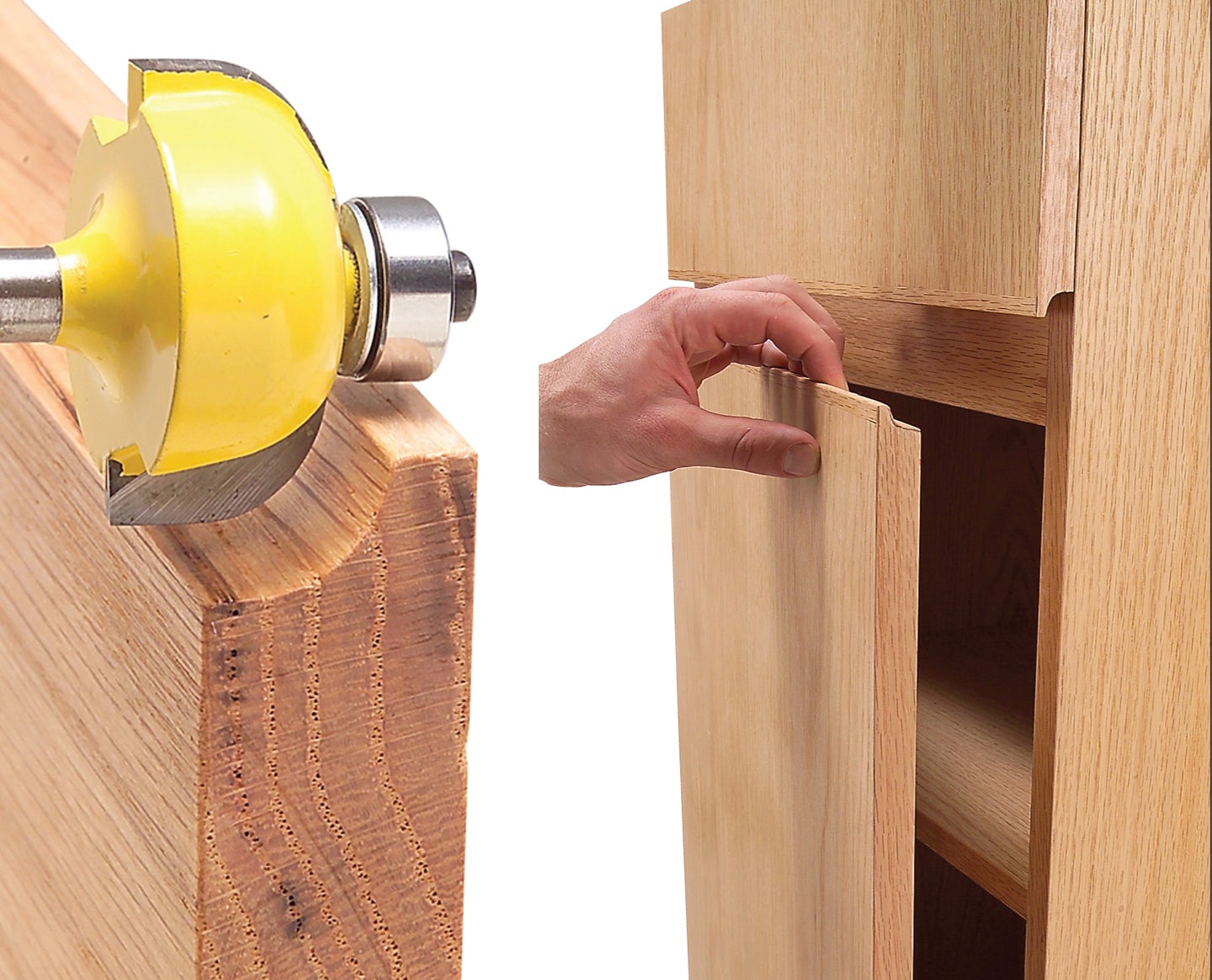
Built-in pull and bit used to make it; image via Woodworking
Built-in pulls: Rather than attaching hardware for door pulls and knobs, cabinets can have built-in grooves that can be used to open doors. This gives a cleaner appearance to the finish face.
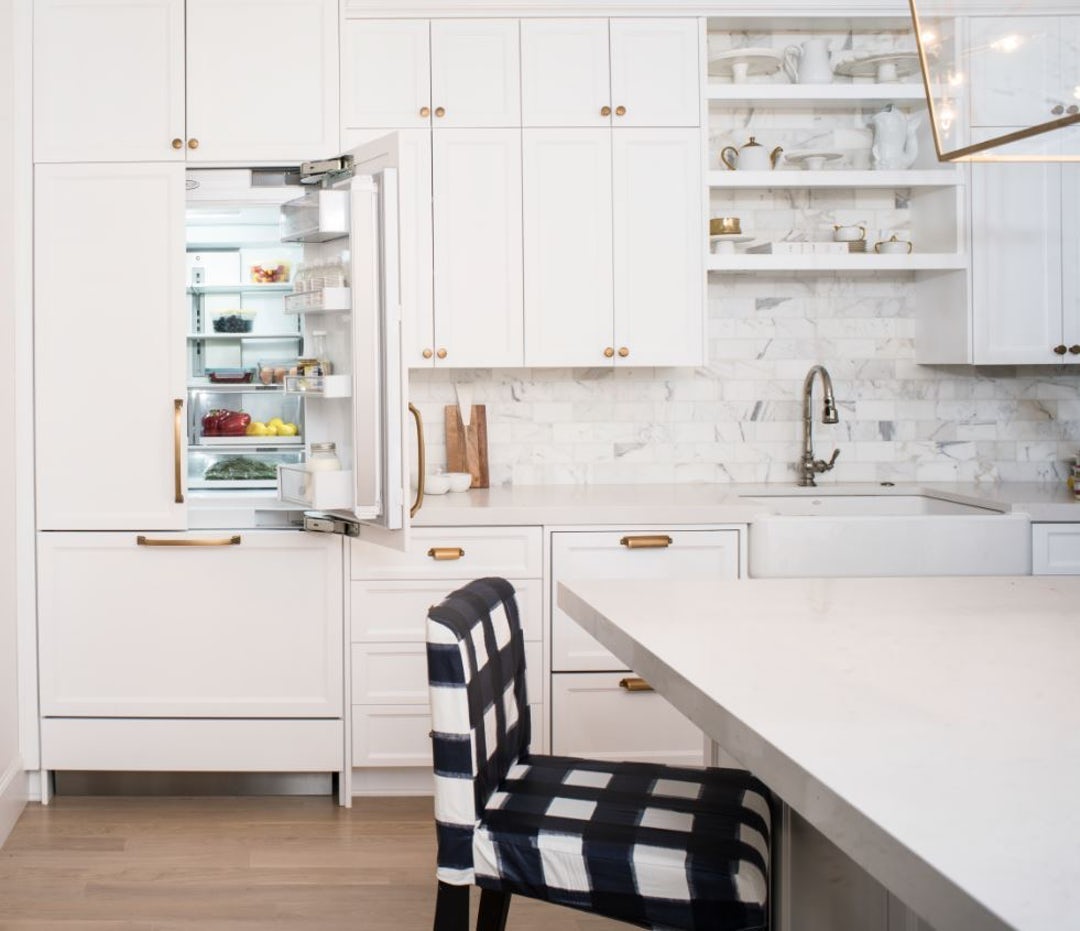
Integrated refrigerator; image via Dwell
Appliance covers: Some appliances, like dishwashers, stove hoods and refrigerators can all be built in or covered with cabinetry. Some appliances, like dishwashers, come in standard sizes, but ovens, cooktops and refrigerators have a wide variety between different models and brands, so these have to be selected before the cabinet doors can be completely designed.
Hardware
Cabinet hardware includes:
- Pulls: Handles mounted to the exterior of doors and drawers with two or more screws and bolts
- Knobs: Handles mounted to the exterior of doors and drawers with a single screw and bolt
- Hinges: Attachments that secure the cabinet door to the frame
- Drawer Slides: Attachments that facilitate the opening and removal of drawers
- Door Catches: Attachments that secure cabinet doors without self-closing hinges against the frame
- Back Plates: Pieces of finished metal that rest between the door and pulls/knobs to protect a cabinet’s surface, cover existing holes or enhance decorative hardware
Application
- Hardware Dimensions: If you know the size of the different hardware that you need, list:
- Length and width
- Center-to-center measurement: The distance between mounting or screw holes
- Projection: The total distance that a pull or knob projects from the cabinet door
- Quantity: How many cabinets are there? How many of each hardware component will you need? Note that:
- Hinges are specified for use on left- or right-hand doors
- The number of hinges you need depends on the height and weight of the door:
- Use twohinges for doors less than 40 inches high and less than 11 pounds
- Use three hinges for doors 40 to 60 inches high and 13 to 20 pounds
- Use four hinges for doors 60 to 80 inches high and 29 to 33 pounds
- Use five hinges for doors 80 to 85 inches high and 40 to 48 pounds
- You may wish to order spare components for future use and replacement
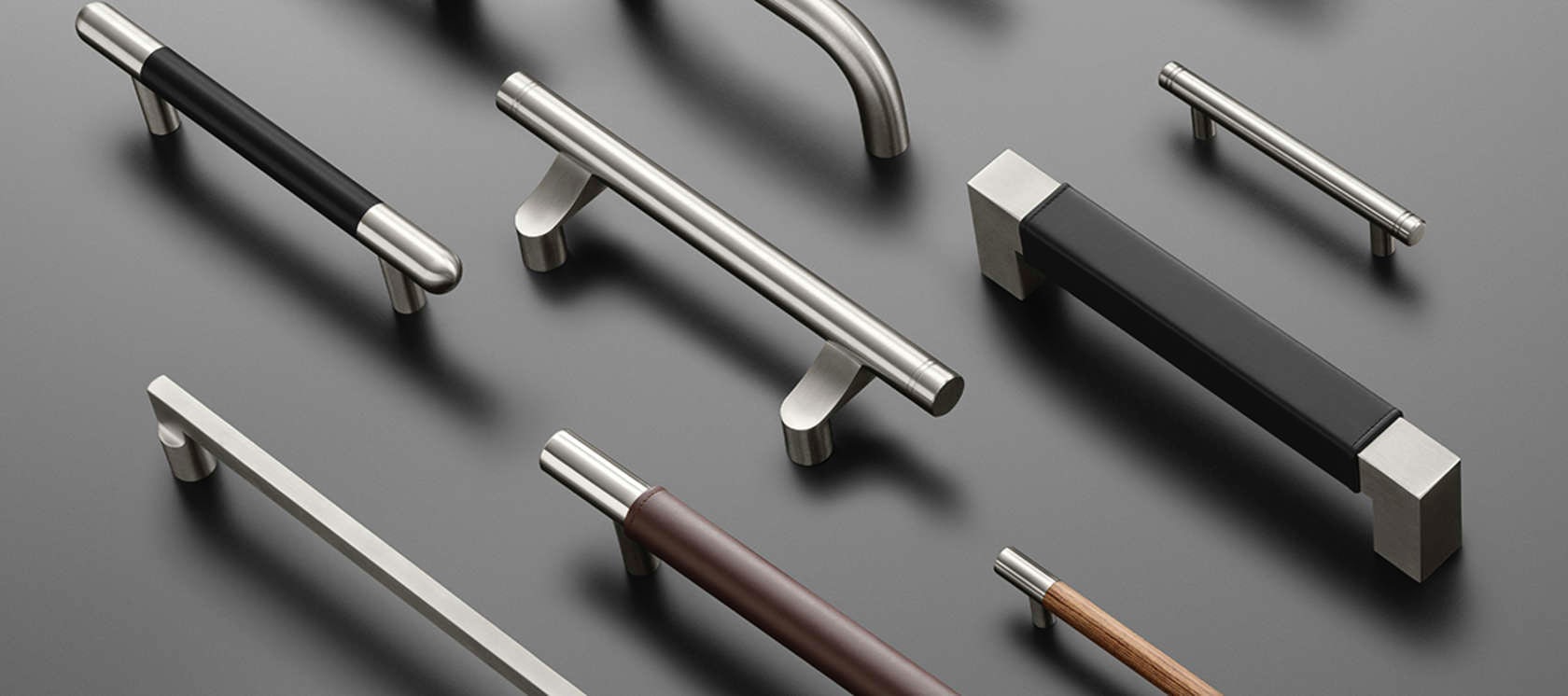
Aesthetic: Upload a picture or rendering to Source as an example or describe how you would like your cabinet hardware to appear. There are many different types of knobs, pulls and hinges.
- Knob/Pull Shape: Many different varieties. Check out Houzz for ideas.
- Hinge Type
- Mortise: Permanent installation hinges in which the areas inside the cabinet door and frame have cutouts to attach the hinges
- Non-mortise: Do not require placement into the cabinetry, instead fastening in with screws
- Fully concealed: Only the surface of the door is outwardly visible
- Semi-concealed: Only the knuckle is visible; for use with inset doors
- European/frameless hinges: Popular for full-overlay and inset doors
- Overlay: For frameless half-overlay doors or face-frame doors that overlap the frame
- Variable overlay: For doors that overlay the frame and have no cutout at the back
- Partial wraparound: Large surface area to improve stability on flush, inset or overlay doors
- 3/8-inch inset: For doors that overlay the frame and have a cutout on the back edge
- H-style: One side attaches to the frame, and the other attaches to the flush mount door
- Butterfly: For flush doors; each wing mounts to the outside surfaces of the cabinet door and frame
- T-style: The vertical piece attaches to the doorframe, and the horizontal piece attaches to the door
- Full-inset pin: For doors completely flush with the face of the cabinet
- Materials (excluding drawer slides and door catches)
- Bronze
- Copper
- Iron
- Polished Chrome
- Sterling
- Pewter
- Brass
- Nickel
- Ceramic (pulls and knobs only)
- Finish Color: If applicable, specify the color, including for drawer slides.
- High shine
- Polished
- Hammered
- Enameled
- Oil brushed
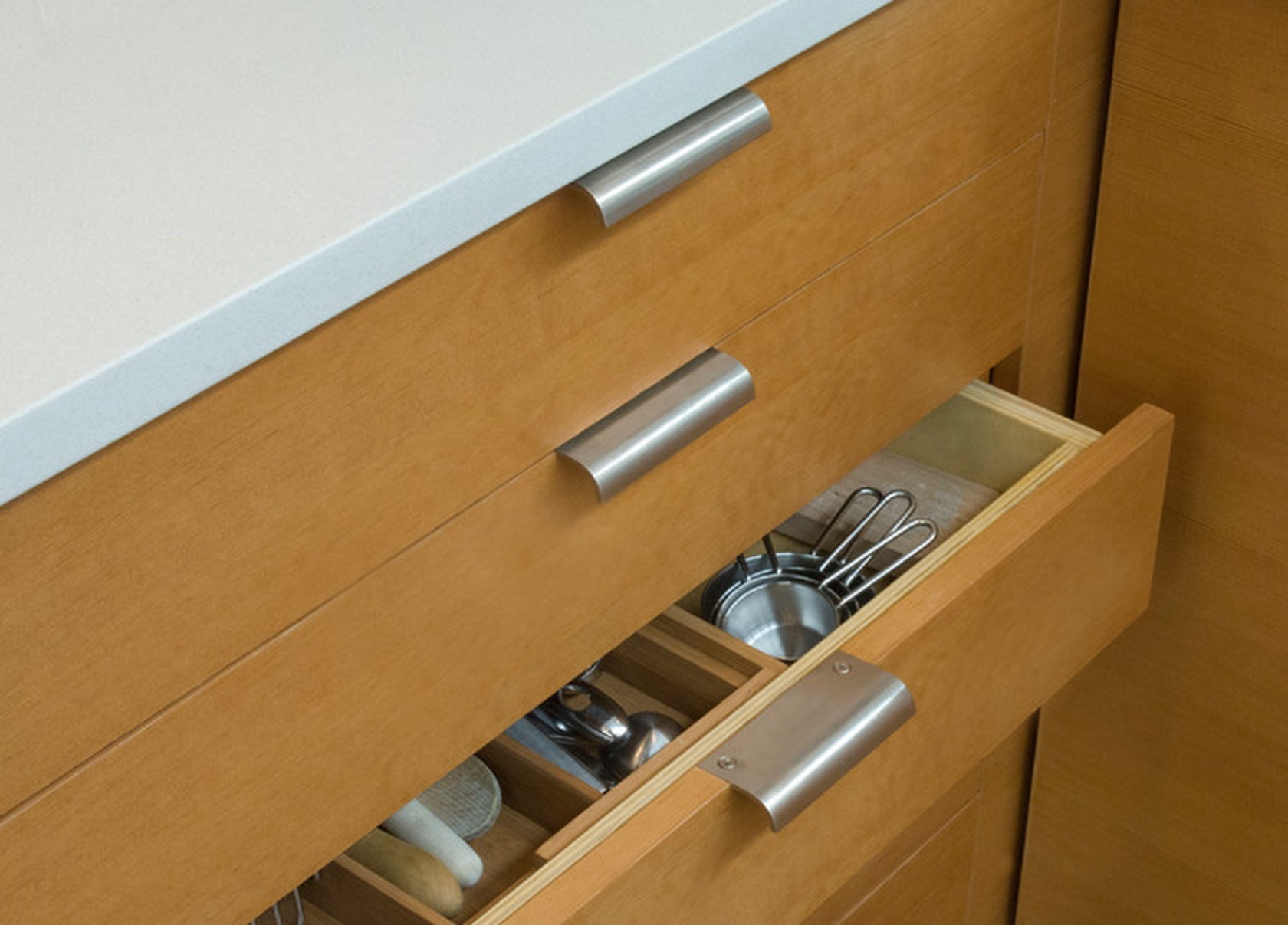
Performance
- Drawer Slides and Rollers: These are available in light, medium and heavy designations, depending on the weight of your drawer.
- Side-mount slides: A slide attaching to each side of the drawer; available with a ball-bearing or roller mechanism
- Center-mount slides: Mount under the center of the drawer; available in classic wood version or with ball-bearing mechanism
- Under-mount slides: Ball-bearing slides sold in pairs; invisible when the drawer is open
- Push to open: Slides open with a nudge to the drawer front, eliminating the need for handles or pulls
- Self close: Slides return the drawer fully into cabinet when drawer is pushed
- Soft close: Slides add a dampening effect to self-close feature, softly returning the drawer into the cabinet and without slamming
- Bearings and rollers create a smoother motion, while full-extension slides enable greater access to the drawer
- Catches
- Magnetic: Metal plates mounted on the door and frame secure door closure
- Spring roller touch: Catches mounted on the door close when the rollers set on the cabinet frame hook in the strike plate
- Ball: Recessed into the edge of the door, while the striker plate is recessed into the jamb
- Double ball: Two balls in a casing hold the striker in place when inserted between them
- Touch latch: Push to latch, push again to release; the main body fits to the inner side of the cupboard, and the striker plate fits to the inside of the door and aligns with the catch
- Accessibility: ADA-accessible cabinet hardware is available for those with limited mobility, arthritis or other special considerations.
Architizer is thrilled to announce that the 2026 A+Product Awards is officially open for submissions! Get your products in front of the AEC industry’s most renowned designers by submitting today.




